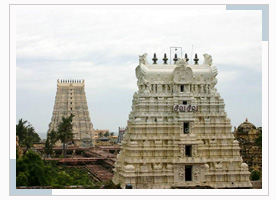Rameshwaram Temple Tamil Nadu
Rameshwaram is significant for the Hindus as a pilgrimage to Benaras is incomplete without a Pilgrimage to  Rameshwaram. The presiding deity is the Linga Of Sri Ranganatha, which happens to be one of the twelve Jyotirlingas of India. Rameshwaram is also popularly referred to as the 'Benaras of the south'. In order to attain Moksha it is believed that the visit to Rameshwaram is mandatory.
Rameshwaram. The presiding deity is the Linga Of Sri Ranganatha, which happens to be one of the twelve Jyotirlingas of India. Rameshwaram is also popularly referred to as the 'Benaras of the south'. In order to attain Moksha it is believed that the visit to Rameshwaram is mandatory.
History of Rameshwaram
According to the Hindu mythology i.e. the story of Ramayana Lord Rama performed thanksgiving rituals to Lord Rama after the battle at Sri Lanka and his triumph over the demon king Ravana. Owing to this Rameshwaram attracts Vaishnavites (worshippers of Lord Vishnu) and Saivites (worshippers of Lord Shiva) alike. Sri Lanka is at a distance of 24 kilometers from Rameshwaram. In fact the entire area of Rameshwaram is associated with various incidents from the Ramayana. Rameshwaram happens to one of the most visited pilgrim sites in India.
The Ramanathaswamy Temple
At the town's core is the Ramanathaswamy Temple, one of the most important temples in southern India. Rameswaram is on an island in the Gulf of Mannar, connected to the mainland at Mandapam by rail, and by one of India's engineering wonders, the Indira Gandhi Bridge. Ramnathswamy temple was built in the 17th century. Situated close to the sea on the eastern side of the island, this temple is famous for its 1200 gigantic granite columns.
The 54 metre tall gopuram (gate-tower), 1220 metres of magnificent corridors and the flamboyant columns embellish and render fame to the temple. The great temple of Sri Ramanatha is connected by tradition with Keshi. A pilgrimage to Kasi is not considered complete without a pilgrimage to Rameswaram. In olden days groups of pilgrims, many of them quite old, walked huge distance to the two temples, taking months and years, and some failing to survive the rigours and dangers of such incredibly long journeys. Men and women know this cost might be exacted of them, but they paid it cheerfully.
The Rameswaram pilgrimage has long been a tradition in South India, particularly in Tamil Nadu, and has passed into folklore. Many kings of old period themselves on having planted columns of victory in Rameswaram. Krishna III the Rashtrakuta, in the tenth century, the Hoysala, Vishnuvardhana, in the twelfth. It was a king of Sri Lanka who according to inscriptions, built the sanctum of the temple.
The temple, which has over the centuries grown into its present gigantic dimensions, stands on the eastern shore of an island, which is shaped like a conch, which Lord Vishnu bears in one of His bands. No field is ploughed or oil pressed anywhere in the island. A magnificent railway bridge, over a kilometre long and constructed at the beginning of the twentieth century, connected it with the mainland. To help the pilgrims walking incredible distances, philanthropists used to construct rest houses at intervals along the way.
The last of them before Rameswaram was Thangachimadam, a few kilometres away on the island. Modern means of transport have made these resthouses superfluous. But in their time they were most useful, even vital. The Sethupathis of Ramanathapuram, of which district Rameswaram is an administrative part were called the guardians of the Sethu", the bridge which, according to tradition, was built for Sri Rama to cross over into Sri Lanka when He set out to recover Sita.
The temple 264m east to west and 200m north to south, and with three prakaras, two big gopuras and two more unfinished ones, faces east, a few metres from the sea. It contains two Lingas under worship. These are innumerable other shrines and twenty-two "tirthas", or sacred bathing places.





